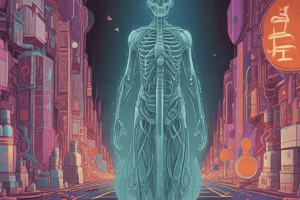Podcast
Questions and Answers
What is one of the primary mechanisms of resistance to Isoniazid?
What is one of the primary mechanisms of resistance to Isoniazid?
- Decreased absorption in the liver
- Mutation in the catalase peroxidase gene (correct)
- Point mutation in the rpoB gene
- Inhibition of drug metabolism
Which drug interaction is associated with Isoniazid?
Which drug interaction is associated with Isoniazid?
- Decreases the efficacy of rifampicin
- Increases absorption of phenytoin
- Enhances metabolism of carbamazepine
- AlOH inhibits absorption of Isoniazid (correct)
Which of the following is a notable adverse effect of Rifampicin?
Which of the following is a notable adverse effect of Rifampicin?
- Nephrotoxicity
- Hepatitis (correct)
- Peripheral neuropathy
- Hyperglycemia
Which of the following drugs is considered a first-line drug for the treatment of tuberculosis?
Which of the following drugs is considered a first-line drug for the treatment of tuberculosis?
What occurs if Rifampicin is used alone in treatment?
What occurs if Rifampicin is used alone in treatment?
What can high doses of Isoniazid potentially lead to?
What can high doses of Isoniazid potentially lead to?
Rifampicin primarily inhibits which enzyme in bacteria?
Rifampicin primarily inhibits which enzyme in bacteria?
How does Isoniazid interact with pyridoxine?
How does Isoniazid interact with pyridoxine?
Which mechanism of resistance is associated with mutations in the katG gene?
Which mechanism of resistance is associated with mutations in the katG gene?
Which adverse effect is most commonly associated with Pyrazinamide?
Which adverse effect is most commonly associated with Pyrazinamide?
Which drug class does Levofloxacin belong to as a second line treatment for tuberculosis?
Which drug class does Levofloxacin belong to as a second line treatment for tuberculosis?
What is the role of the embCAB gene in tuberculosis resistance?
What is the role of the embCAB gene in tuberculosis resistance?
Which of the following drugs is not recommended for use during pregnancy?
Which of the following drugs is not recommended for use during pregnancy?
Which adverse effect can be precipitated by Ethambutol?
Which adverse effect can be precipitated by Ethambutol?
Which mechanism is involved in the resistance against the drug that inhibits DNA synthesis in tuberculosis?
Which mechanism is involved in the resistance against the drug that inhibits DNA synthesis in tuberculosis?
Which second-line drug is known to inhibit the folate pathway?
Which second-line drug is known to inhibit the folate pathway?
Flashcards
Ethambutol (Myambutol)
Ethambutol (Myambutol)
Antituberculosis drug inhibiting arabinosyl transferases in cell wall biosynthesis.
Retrobulbar Neuritis
Retrobulbar Neuritis
Adverse effect of Ethambutol, causing impaired vision and color discrimination.
Pyrazinamide
Pyrazinamide
Tuberculosis drug that becomes active inside acidic phagosomes of macrophages. A prodrug.
Pyrazinoic acid
Pyrazinoic acid
Signup and view all the flashcards
Hepatotoxicity
Hepatotoxicity
Signup and view all the flashcards
Second-Line Oral (SLO) Drugs
Second-Line Oral (SLO) Drugs
Signup and view all the flashcards
Fluoroquinolones
Fluoroquinolones
Signup and view all the flashcards
Antituberculosis Agents
Antituberculosis Agents
Signup and view all the flashcards
Mechanism of Action (MoA)
Mechanism of Action (MoA)
Signup and view all the flashcards
Minimum Inhibitory Concentration (MIC)
Minimum Inhibitory Concentration (MIC)
Signup and view all the flashcards
Isoniazid (INH)
Isoniazid (INH)
Signup and view all the flashcards
INH mechanism of resistance
INH mechanism of resistance
Signup and view all the flashcards
INH Pharmacokinetics
INH Pharmacokinetics
Signup and view all the flashcards
INH Adverse Effects
INH Adverse Effects
Signup and view all the flashcards
INH Drug Interactions
INH Drug Interactions
Signup and view all the flashcards
Rifampicin
Rifampicin
Signup and view all the flashcards
Rifampicin Mechanism Resistance
Rifampicin Mechanism Resistance
Signup and view all the flashcards
Rifampicin Pharmacokinetics
Rifampicin Pharmacokinetics
Signup and view all the flashcards
Rifampicin adverse effects
Rifampicin adverse effects
Signup and view all the flashcards
Rifampicin drug interactions
Rifampicin drug interactions
Signup and view all the flashcards
Study Notes
Tuberculosis Treatment
- First Line Drugs (FLDs): Oral drugs used for initial treatment
- Isoniazid (INH/H)
- Rifampicin (R)
- Pyrazinamide (Z)
- Ethambutol (E)
Isoniazid (INH)
- Mechanism of Action: Inhibits cell wall synthesis by interfering with mycolic acid synthesis
- Structurally related to vitamin B6
- Activated by KatG in M. Tuberculosis
- Effective on both intracellular and extracellular bacilli
- Resistance Mechanism: Mutations in catalase peroxidase and the promoter gene inhA
- Pharmacokinetics: Penetrates body fluids, accumulates in caseated lesions
- Acetylated in the liver, resulting in faster elimination of the acetyl form
- Uses: Combined with other drugs for treatment; used alone for prophylaxis
- Adverse Effects:
- Allergic reactions
- Hepatotoxicity (increased risk with age, alcohol, drug use)
- Peripheral neuropathy (with high doses), minimized with pyridoxine
- Inhibits metabolism of other drugs (e.g., diphenylhydantoin)
- Drug Interactions: Alcohol and certain medications (e.g., phenytoin, carbamazepine) can affect INH absorption and metabolism
Rifampicin, Rifapentine, Rifabutin
- Mechanism of Action: Inhibits DNA-dependent RNA polymerase
- Bactericidal: Effective against various bacteria (including M. tuberculosis, M. leprae, and others)
- Resistance: Can develop quickly with monotherapy due to mutations in the rpoB gene
- Pharmacokinetics: Well absorbed orally; highly protein-bound; excreted primarily via liver and bile
- Induces hepatic microsomes and therefore affects the metabolism of other drugs
- Adverse effects: Hepatitis (dose-dependent and reversible)
- Nausea, vomiting, dizziness, fatigue, fever, jaundice
- Urine discoloration
- Drug Interactions: Induces metabolism of other drugs like oral contraceptives, anticoagulants, protease inhibitors
Ethambutol (Myambutol)
- Mechanism of Action: Inhibits arabinosyl transferases involved in cell wall biosynthesis
- Mechanism of Resistance: Mutations in embB gene
- Adverse Effects:
- Reversible retrobulbar neuritis (visual impairment)
- Red-green colour vision loss
- Mild gastrointestinal (GI) disturbances
- Potential for gout precipitation (due to decreased urate secretion)
Pyrazinamide
- Mechanism of Action:
- Derivative of nicotinamide
- Converted to pyrazinoic acid by bacterial pyrazinamidase
- Bactericidal, active in acidic environments of macrophage phagosomes (pH 5)
- Resistance Mechanism: Mutations in the pcnA gene (which encodes pyrazinamidase)
- Adverse Effects: Hepatotoxicity, vomiting, anorexia
- Special Considerations: Not recommended for use during pregnancy
- Action on TB: Acts on extracellular tubercle bacilli
- Other Considerations: Hepatotoxicity is a major concern; inhibits urate excretion and can precipitate gout attacks
Second-Line Drugs (SLDs)
- Fluoroquinolones: Levofloxacin, Moxifloxacin, Gatifloxacin
- Other SLDs: Ethionamide, Prothionamide, Cycloserine, Terizidone, Para-aminosalicylic Acid (PAS), Thiacetazone
MIC and Mechanism of Action Table
- Data on Minimum Inhibitory Concentration (MIC), genes involved in resistance, roles in resistance, and mechanism of action for various antituberculosis drugs.
Tuberculosis Treatment Categories
- Detailed descriptions of different treatment categories for latent and active tuberculosis infections, including specific drug combinations and durations.
Studying That Suits You
Use AI to generate personalized quizzes and flashcards to suit your learning preferences.




